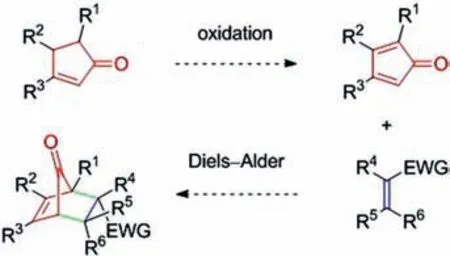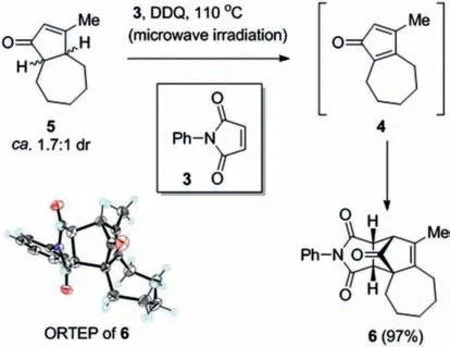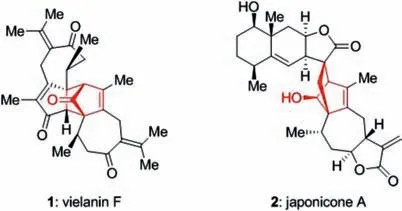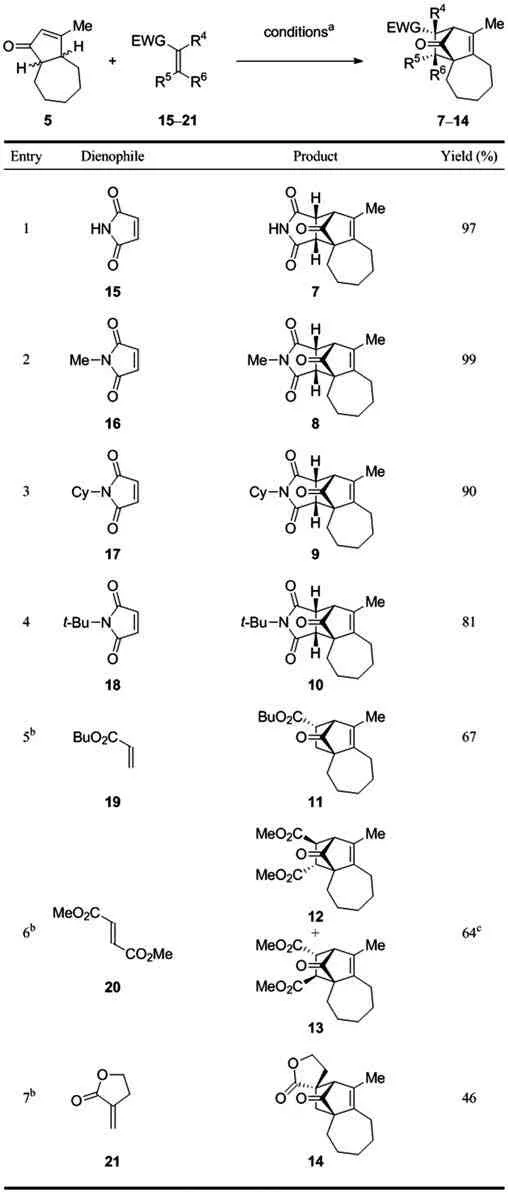Construction of alkyl-substituted 7-norbornenones through Diels-Alder cycloaddition of electron-deficient olefins and a cyclopentadienone derivative generated in situ
Shanxiang Liu,Jinxin Wang,Yuyong Ma,Xin Cao,Wei-Dong Zhang,Ang Li,c,*
a School of Traditional Chinese Pharmacy,China Pharmaceutical University,Nanjing 211198,China
b State Key Laboratory of Bioorganic and Natural Products Chemistry,Center for Excellence in Molecular Synthesis,Shanghai Institute of Organic Chemistry,Chinese Academy of Sciences,University of Chinese Academy of Sciences,Shanghai 200032,China
c State Key Laboratory of Innovative Natural Medicine and Traditional Chinese Medicine Injections,Jiangxi Qingfeng Pharmaceutical Co.Ltd.,Ganzhou 341000,China
d Department of Phytochemistry,School of Pharmacy,Second Military Medical University, Shanghai 200433,China
ABSTRACT Dimeric sesquiterpenoids possessing densely substituted 7-norbornenone/7-norbornenol motifs pose a considerable challenge for chemical synthesis.From a strategic perspective,one could envision intermolecular Diels-Alder cycloaddition as a straightforward method for assembling alkyl-substituted 7-norbornenones.However,this approach is hindered by lability of the required dienes,namely alkylsubstituted cyclopentadienones.Here we report a one-pot protocol for construction of alkyl-substituted 7-norbornenones from electron-deficient olefins and a cyclopentenone derivative.DDQ was found to be an effective oxidant for generating a cyclopentadienone intermediate in situ from the enone.A series of sterically congested 7-norbornenone-containing polycyclic compounds were prepared by using this protocol.
Keywords:7-Norbornenone Alkyl-substituted cyclopentadienone Diels-Alder cycloaddition Dimeric sesquiterpenoid
Dimeric sesquiterpenoids have long been intriguing targets to the synthesis community[1,2].Among them,a class of molecules possessing densely substituted 7-norbornenone/7-norbornenol motifs,such as vielanin F[3]and japonicone A[4](1 and 2,Fig.1),pose a significant challenge for chemical synthesis.From a strategic perspective,the 7-norbornenone core could be constructed through an intermolecular Diels-Alder reaction of an cyclopentadienone derivative(as a diene)and an electron deficient olefin(as a dienophile).Of note,preparation of aryl-substituted cyclopentadienones is well precedented in the literature[5–10].In contrast,alkyl-substituted cyclopentadienones have barely been isolated and characterized to our knowledge,presumably due to its strong tendency to dimerize in a[4+2]manner[11,12].Cyclopentadienone equivalents(e.g.,the corresponding ketal[13–15]and fulvalene[16,17]derivatives)have been employed as dienes in Diels-Alder reactions;however,synthesis of such equivalents bearing multiple alkyl substituents has proved nontrivial[14–16].Our experience[18–23]with the Diels-Alder reaction in natural product synthesis suggested that a convenient protocol for preparing alkyl-substituted cyclopentadienonesin situwould enable expeditious construction of corresponding 7-norbornenones through Diels-Alder cycloaddition.Porco and co-workers reported an elegant synthesis of chamaecypanone C featuring an intermolecular Diels-Alder reaction[24];a bis-aryl cyclopentadienone was generatedin situfrom a corresponding cyclopentenone derivative upon treatment with DDQ[25]and used as a dienophile in the Diels-Alder reaction.Inspired by this work,we envisioned a similar strategy forin situpreparation of alkyl-substituted cyclopentadienones which could be exploited to assemble multisubstituted 7-norbornenones(Scheme 1).It is noteworthy that the cyclopentadienone intermediates would serve as dienes rather than dienophiles in the Diels-Alder reactions(Scheme 1).Herein,we describe our endeavors toward synthesis of 7-norbornenonecontaining polycyclic compounds based on this strategy.

Scheme 1.A Diels-Alder strategy for construction of alkyl-substituted 7-norbornenones using cyclopentadienone intermediates generated in situ from corresponding cyclopentenone derivatives.EWG = electron withdrawing group.

Scheme 2.A one-pot dehydrogenation/Diels-Alder cycloaddition sequence for assembly of tetracyclic compound 6.Reagents and conditions:3(1 equiv.),5(3.0 equiv.),DDQ(4.5 equiv.),toluene,110 °C(microwave irradiation),12 h.

Fig.1.Selected dimeric sesquiterpenoids containing 7-norbornenone/7-norbornenol(highlighted in red)motifs.
We first investigated the Diels-Alder reaction ofNphenylmaleimide(3)and cyclopentadienone derivative 4 generatedin situfromα,β-unsaturated enone 5.Compound 5 was prepared from cycloheptanone(see Supporting information for details)as a mixture of diastereomers(ca.1.7:1 dr).Under the Porco conditions(DDQ,150 °C,o-dichlorobenzene)[24],no cycloadducts were detected;instead,precursor 5 underwent rapid decomposition.To our delight,lowering the reaction temperature(110 °C,toluene)led to formation ofendo-cycloadduct 6,despite a modest yield.Microwave irradiation(110 °C,toluene)significantly improved the overall efficiency of this sequence,giving 6 in 97%yield(Scheme 2).A trace amount of a homodimer of 4 was also generated under these conditions.The structure of 6 was verified by X-ray crystallographic analysis(Scheme 2).
Having established the one-pot dehydrogenation/cycloaddition protocol,we moved forward to prepare a series of polycyclic compounds sharing a 7-norbornenone core(7–14,Table 1)from diene precursor 5 and various dienophiles(15–21).Maleimide(15)and its derivatives(16–18)performed well in the one-pot reactions,andendo-cycloadducts 7–10 were isolated in good to excellent yields(entries 1–4,Table 1).We then examined butyl acrylate(19)as a dienophile.However,the desired product was not observed under the standard conditions,presumably due to insufficient reactivity of the dienophile.Our experience[19,21,26]with lanthanide tris(β-diketonate)complexes as Lewis acids in or-ganic synthesis suggested that Er(fod)3might serve as an effective promoter for the intermolecular Diels-Alder reaction.To our delight,cycloadduct 11 was obtained in 67% yield in the presence of Er(fod)3(entry 5).This modified protocol found more applications in the synthesis ofα,β-unsaturated ester/lactone-derived 7-norbornenones(entries 6 and 7).When dimethyl fumarate(20)was employed as a dienophile,an inseparable mixture of 12 and 13(ca.1.4:1 ratio)was produced in 64% yield(entry 6).Similarly,we prepared compound 14 representing the congested tetracyclic core of japonicone A(2),through cycloaddition of exocyclic olefin 21 and diene 4 generatedin situ.

Table 1 Preparation of 7-norbornenone-containing polycyclic compounds from diene precursor 5 and various dienophiles.
In summary,we developed a convenient protocol forin situgeneration of an alkyl-substituted cyclopentadienone from a corresponding cyclopentenone,which enabled an expeditious Diels-Alder approach for assembling multisubstituted 7-norbornenones.The described chemistry is expected to facilitate the synthesis of dimeric sesquiterpenoids containing alkyl-substituted 7-norbornenone/7-norbornenol motifs.
Declaration of competing interest
The authors declare that they have no known competing financial interests or personal relationships that could have appeared to influence the work reported in this paper.
Acknowledgments
This work was supported by Ministry of Science and Technology(National Key Research and Development Program of China,Nos.2019YFC1711000 and 2018YFA0901900),National Natural Science Foundation of China(Nos.21931014,21525209,21621002,21772225,21761142003 and 82003624),Chinese Academy of Sciences(Strategic Priority Research Program,No.XDB20000000;International Partner Program,No.121731KYSB20190039;Key Research Program of Frontier Sciences,No.QYZDB-SSW-SLH040),Science and Technology Commission of Shanghai Municipality(Nos.17XD1404600 and 20YF1458700),State Key Laboratory of Innovative Natural Medicine and Traditional Chinese Medicine Injections(No.QFSKL2017002),and K.C.Wong Education Foundation.
Supplementary materials
Supplementary material associated with this article can be found,in the online version,at doi:10.1016/j.cclet.2021.09.030.
 Chinese Chemical Letters2022年4期
Chinese Chemical Letters2022年4期
- Chinese Chemical Letters的其它文章
- Key progresses of MOE key laboratory of macromolecular synthesis and functionalization in 2020
- Small nanoparticles bring big prospect:The synthesis,modification,photoluminescence and sensing applications of carbon dots
- Cell membrane-coated nanoparticles for immunotherapy
- Diketopyrrolopyrrole-derived organic small molecular dyes for tumor phototheranostics
- Exosome based miRNA delivery strategy for disease treatment
- Recent advances in targeted stimuli-responsive nano-based drug delivery systems combating atherosclerosis
